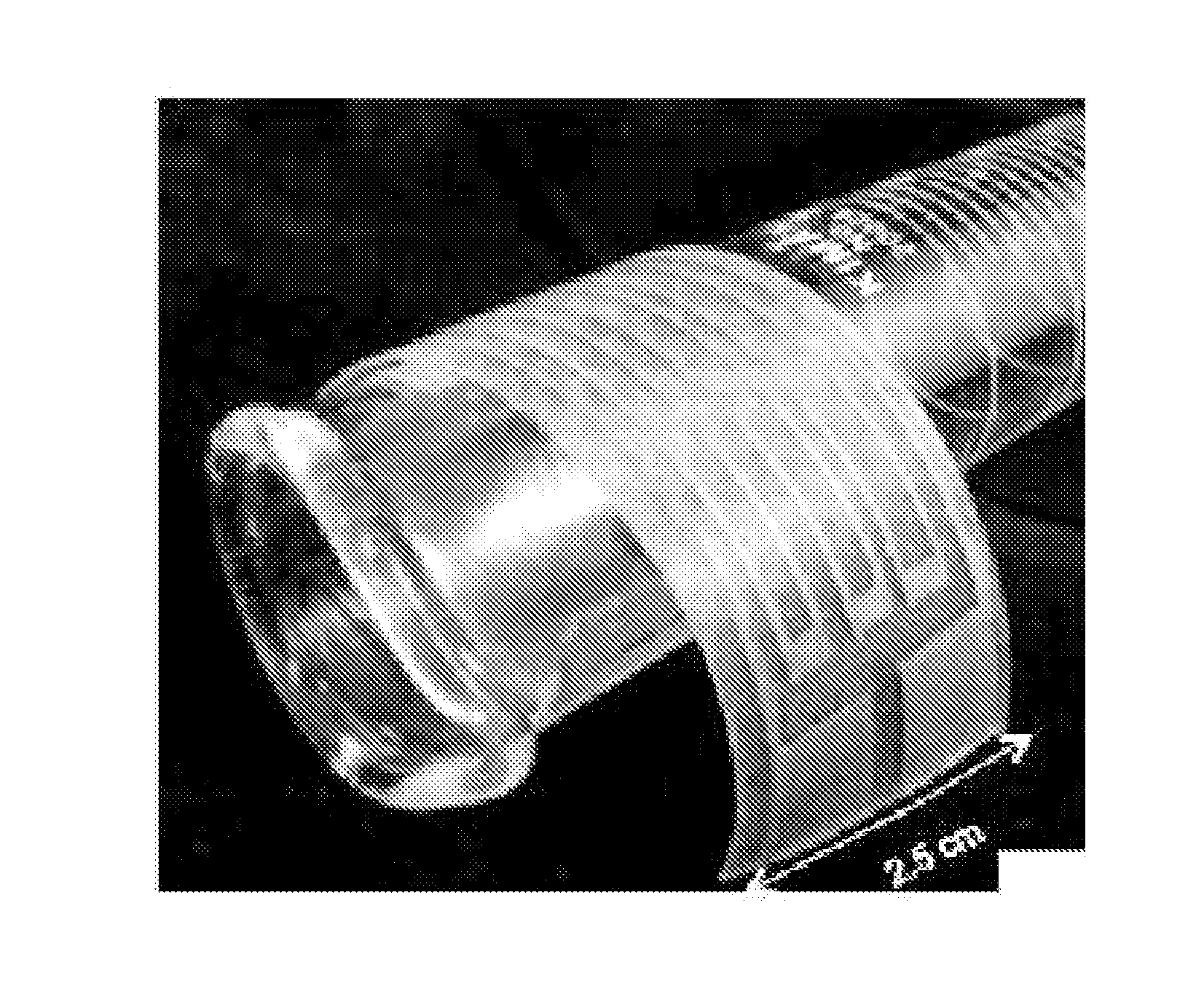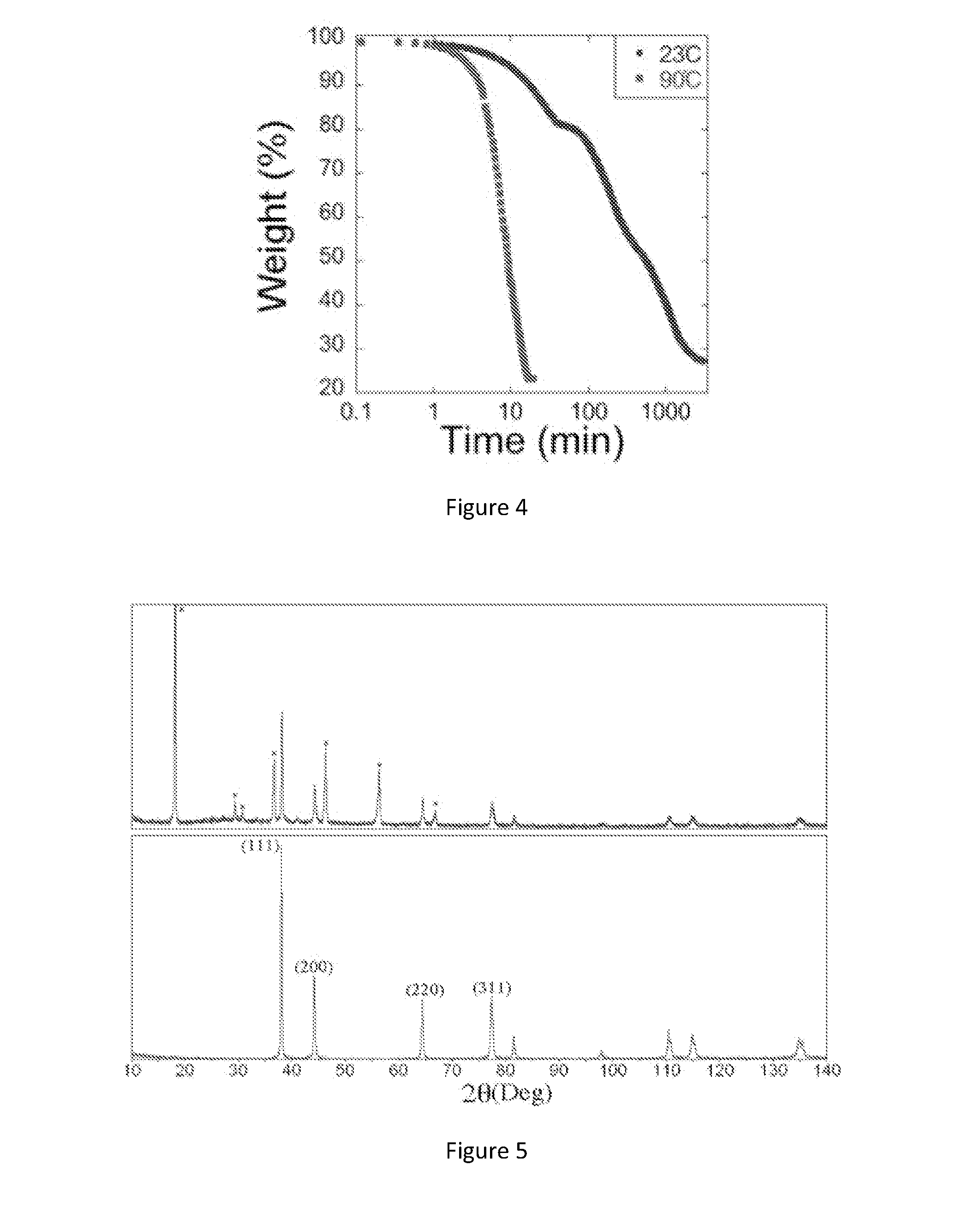Ink composition for making a conductive silver structure
a silver structure and composition technology, applied in the field of silver-based inks, can solve the problems of incompatible ink with many plastic and paper substrates used in flexible electronic and biomedical devices, and cannot be compatible with substrates
- Summary
- Abstract
- Description
- Claims
- Application Information
AI Technical Summary
Benefits of technology
Problems solved by technology
Method used
Image
Examples
example 1
[0046]In an illustrative experiment, silver acetate is dissolved in butylamine. This solution may be diluted with an alcohol, ester, water, or other solvent for processing. Typically, hydroxyethylcellulose (a cellulose derivative viscosifier) is added at a very small weight percentage to promote adhesion to the desired substrate. After thorough mixing, a small amount of formic acid is added to the mixture. After initial mass transfer of the acid to the mixture, the solution turns cloudy, possibly due to the initial formation of some small silver particles. The solution can then be centrifuged to form a substantially clear solution. The inventors have observed that water-based solutions remain clear for about 10 days, whereas ethanol-based solutions begin to appear cloudy within 24 to 48 hours.
[0047]The formic acid preferentially complexes with the butylamine since it is basic and does not immediately reduce the silver in solution. Since butylamine (boiling point about 78° C.) is typ...
example 2
[0049]In another illustrative experiment, silver acetate (CH3COOAg, ReagentPlus®, 99%) and formic acid (HCOOH, ACS Reagent, ≧88%) were purchased from Sigma-Aldrich (Milwaukee, Wis., USA), and ammonium hydroxide (Certified A.C.S. Plus, 29.3% assay) was purchased from Fisher Scientific (Pittsburgh, Pa., USA). All chemicals were used without further purification.
[0050]Reactive silver inks were synthesized by vortex mixing 1 g of silver acetate into 2.5 mL aqueous ammonium hydroxide at room temperature for 15 sec. Formic acid (0.2 mL) was then titrated into the solution dropwise for 60 sec, vortex mixing after each drop. The solution changed in color from light orange to brown to grayish black indicating the rapid reduction of silver ions to large silver particles. The solution remained undisturbed for 12 h to allow the large particles to settle out yielding a clear supernatant that was decanted and filtered through a 200 nm syringe filter (Whatman Filters, Anotop 25). This clear soluti...
example 3
[0066]In another illustrative experiment, 0.5 g silver acetate is dissolved in 1.4 mL amylamine. This solution is diluted with 1 mL water and 125 μL propylene glycol. After thorough mixing, 90 μL formic acid is added to the mixture to form an ink composition. The ink composition has a translucent yellow appearance, which may be distinguishable from a clear, colorless appearance of an ink composition utilizing ammonia as the primary complexing agent.
[0067]This ink composition may be useful for inkjet printing and / or spin coating. When heated to 100° C. for 2 minutes, the ink composition may produce a silver structure having a conductivity of greater than about 50% of the conductivity of bulk silver.
[0068]The mixture may be placed at a temperature near −20° C. prior to addition of the formic acid. This may enable a yield of the solution of greater than or equal to about 90%, preferably greater than or equal to about 99% to be achieved. The yield of the solution may represent the amoun...
PUM
| Property | Measurement | Unit |
|---|---|---|
| viscosity | aaaaa | aaaaa |
| viscosity | aaaaa | aaaaa |
| boiling point | aaaaa | aaaaa |
Abstract
Description
Claims
Application Information
 Login to View More
Login to View More - R&D
- Intellectual Property
- Life Sciences
- Materials
- Tech Scout
- Unparalleled Data Quality
- Higher Quality Content
- 60% Fewer Hallucinations
Browse by: Latest US Patents, China's latest patents, Technical Efficacy Thesaurus, Application Domain, Technology Topic, Popular Technical Reports.
© 2025 PatSnap. All rights reserved.Legal|Privacy policy|Modern Slavery Act Transparency Statement|Sitemap|About US| Contact US: help@patsnap.com



